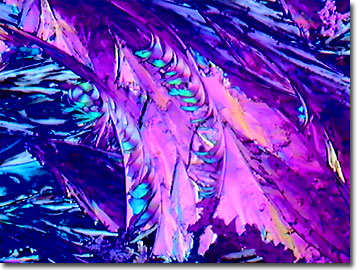Polarized Light Digital Image Gallery
Cinnamic Acid
Cinnamic acid, a derivative of phenylalanine, composes a relatively large family of organic acid isomers that are extracted from plants or synthesized in the laboratory or chemical factory. Most famous as the phenolic compound that gives oil of cinnamon its characteristic odor and flavor, cinnamic acid appears to have antibacterial, antifungal, and parasite fighting abilities. In wine, cinnamic acid and its derivatives join benzoic acid derivatives and flavinoids in creating pigments and tannin agents that give each vintage it characteristic bouquet and color.

Also known as phenylacrylic acid, cinnamic acid forms monoclinic crystals, as needles or prisms, with melting points of 133 degrees Celsius and boiling points of 300 degrees Celsius. Composed of 9 carbon, 8 hydrogen, and 2 oxygen atoms, cinnamic acid is classified as a skin, eye, and respiratory irritant and is soluble in water or alcohol. Historically, xenobiotic metabolism (oxidation of chemicals foreign to the body) was first postulated and demonstrated in 1842 by feeding cinnamic acid to people and dogs and then isolating hippuric acid in their urine. This pioneering research was the basis of the newly created synthetic pharmaceutical industry, thus allowing the prediction of the fate of new compounds administered to organisms, and realization that the body had capabilities to perform chemistry that, at the time, was not possible in the laboratory.
In nature, cinnamic acid derivatives are important metabolic building blocks in the production of lignins for higher plants. The diverse flavinoids of the plant world, responsible for the pigments that give flowers their bright colors that attract pollinators and pungent tastes that deter herbivores, are biosynthesized with cinnamic acid as an intermediate. For use in the perfume production, food industry, pharmaceuticals, medicine, and production of other chemicals, cinnamic acid is synthesized on the commercial scale from styrene and carbon tetrachloride. An important pharmaceutical for high blood pressure and stroke prevention, known as coumarin or oxy-cinnalnic acid, is a derivative of cinnamic acid. Known as storax or balsam of Peru to herbalists and early perfumers for centuries, cinnamic acid (up to 23 percent) is the major component of extracts derived from balsam tree resins, wood, and inner bark. Used as an expectorant and antiseptic as well as the source of many other cures for diseases and parasites, a spice trade based on storax was forged from the Far East through the ancient Middle East to Europe and North Africa. In the United States, herbalists, Native Americans, and early physicians used extractions from the related sweet gum tree to treat coughs, diarrhea, and dysentery.
Contributing Authors
Omar Alvarado, Thomas J. Fellers and Michael W. Davidson - National High Magnetic Field Laboratory, 1800 East Paul Dirac Dr., The Florida State University, Tallahassee, Florida, 32310.
BACK TO THE POLARIZED LIGHT IMAGE GALLERY
BACK TO THE DIGITAL IMAGE GALLERIES
Questions or comments? Send us an email.
© 1995-2025 by Michael W. Davidson and The Florida State University. All Rights Reserved. No images, graphics, software, scripts, or applets may be reproduced or used in any manner without permission from the copyright holders. Use of this website means you agree to all of the Legal Terms and Conditions set forth by the owners.
This website is maintained by our
Graphics & Web Programming Team
in collaboration with Optical Microscopy at the
National High Magnetic Field Laboratory.
Last Modification Friday, Nov 13, 2015 at 01:19 PM
Access Count Since September 17, 2002: 18650
Visit the website of our partner in introductory microscopy education:
|
|
